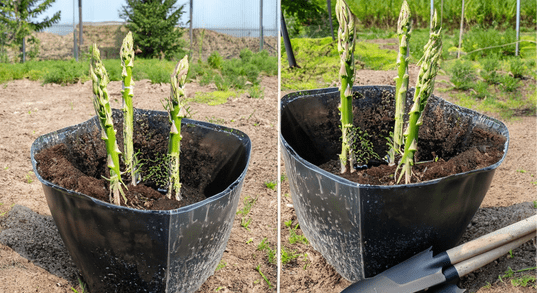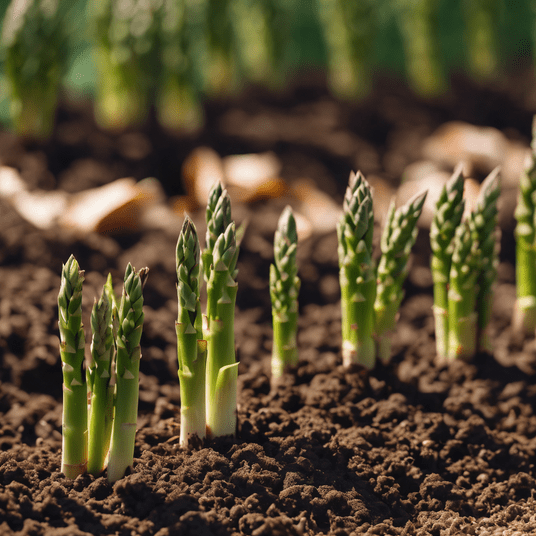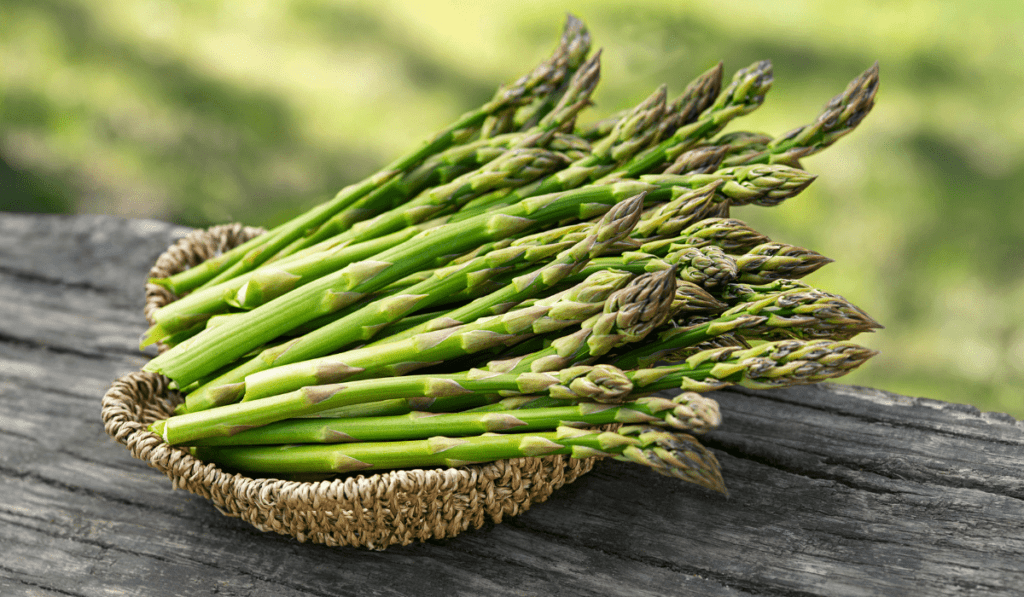Ready to Grow your asparagus in pots? Let’s keep it easy! This guide unfolds 7 straightforward steps to grow amazing asparagus in pots. You don’t need to be a gardening expert. Just be curious! Join me on this journey, and soon you’ll be relishing the delight of homegrown asparagus, right from your pots. Let’s get those spears thriving
A Step-by-step Guide on Growing Asparagus in Pots
1. Choosing Containers for Asparagus
Size Matters: Select a deep pot, at least 18-24 inches in diameter and depth, to accommodate the extensive root system.
Material: Use sturdy materials like wood or thick plastic to handle the weight of the soil and plant.
2. Soil and Planting
Soil Composition: Use a mix of high-quality potting soil with compost or well-rotted manure for nutrients.
Planting: Plant one-year-old crowns, burying them about 6 inches deep. Place the crowns gently on a mound of soil and spread the roots.
3. Location and Sunlight
Sun Requirements: Position the container in a location that receives full sun, mimicking the plant’s natural growing conditions.
Moving: Consider placing the container on a dolly or cart for mobility, as they’ll need protection from extreme weather.
4. Watering and Feeding
Water Needs: Keep the soil consistently moist but not waterlogged. Containers dry out faster than ground soil, so monitor moisture levels closely.
Fertilizing: Feed your potted asparagus with a balanced liquid fertilizer throughout the growing season.
5. Ongoing Care
Staking: As the ferns grow, they may need support. Use stakes or a trellis within the container to prevent them from flopping over.
Winter Care: In colder climates, protect your potted asparagus from freezing by moving it to a sheltered location.
6. Harvesting
Patience is Key: Wait until the third year to start harvesting to allow the plants to establish.
Harvest Method: Cut or snap spears when they reach about 6-8 inches in height.
7. Common Pests and Problems
- Watch for common asparagus pests like asparagus beetles.
- Container plants can be susceptible to root rot, so ensure good drainage.
Conclusion
With the right container, soil, and care, you can grow asparagus in pots and enjoy this perennial vegetable’s harvest. Potted asparagus requires some additional attention compared to ground-grown plants, particularly regarding watering and winter protection. With patience and care, container-grown asparagus can be just as successful and rewarding.
What type of soil is best for asparagus?
Asparagus thrives in well-drained, sandy loam soil with a pH level between 6.5 and 7.5. This type of soil provides good aeration and drainage, which is essential for healthy asparagus growth. To improve the soil, you can add organic matter like compost or well-rotted manure. Make sure the soil is loose and fertile to support the development of strong asparagus spears. Soil preparation is key to a successful asparagus bed!
Should I plant male or female asparagus?
It’s generally recommended to plant male asparagus varieties for a more productive and efficient asparagus bed. Male asparagus plants produce larger and more tender spears because they don’t expend energy on seed production, unlike female plants. This means you’ll get a better harvest from male asparagus plants. So, if you have the choice, opt for male asparagus varieties for your garden.
What happens if you don’t cut asparagus?
If you don’t cut asparagus spears when they are ready for harvest, they will continue to grow and eventually mature into tall, fern-like foliage. Allowing the spears to grow into ferns is not a problem and won’t harm the plant. In fact, it’s a natural part of the asparagus lifecycle. The ferns will photosynthesize and store energy in the roots for the next year’s crop. So, whether you harvest the spears or let them become ferns, your asparagus plants will continue to thrive and produce for years to come.
How do I know when my asparagus is ready to harvest?
Asparagus is ready to harvest when the spears are of the appropriate size and thickness, usually about 6 to 8 inches in length and about the thickness of your pinky finger. Here’s how to tell if it’s ready:
Look for the right size: The spears should be at least 6 inches long but no longer than 8 inches. They should be firm and straight.
Check the tips: The spear tips should still be tightly closed, not starting to spread open.
Assess the thickness: The spears should have a thickness similar to your pinky finger. Thicker spears can be tough and woody.
Harvest regularly: Don’t let the spears grow too long, as they become tougher and less flavorful. Harvest every 2-3 days during the peak season.
Remember, the exact timing can vary depending on your local climate and asparagus variety, so keep a close eye on your plants, and you’ll become an expert at knowing when to harvest your asparagus!



